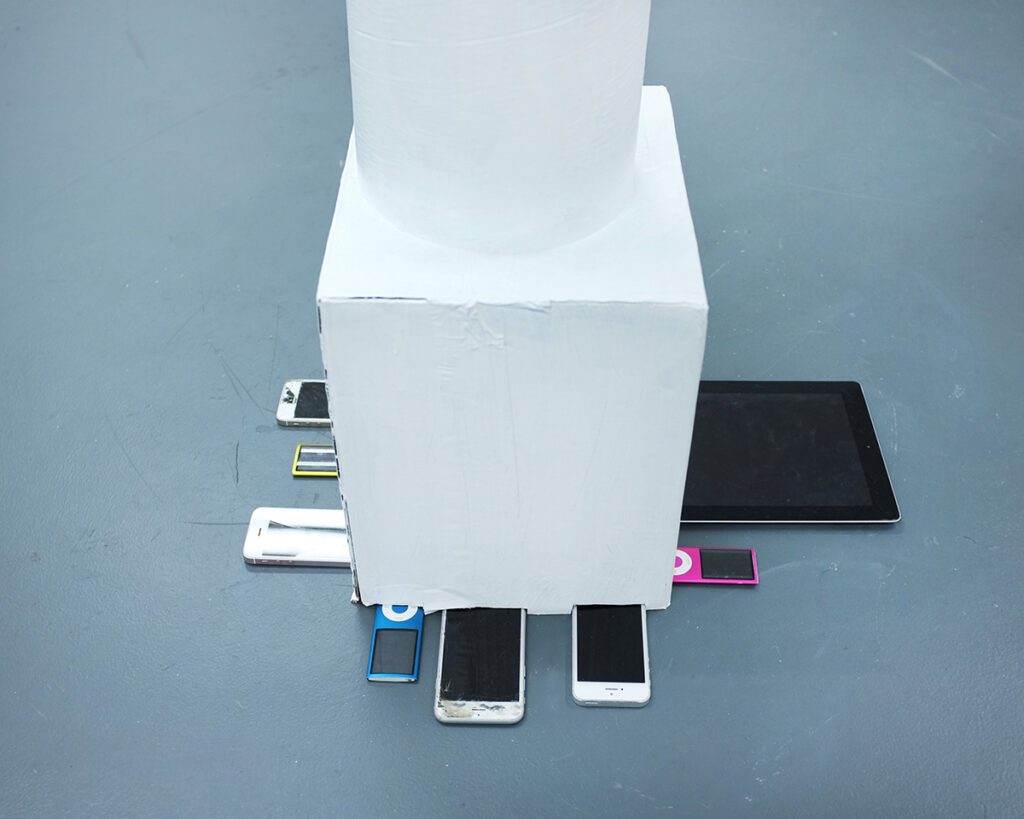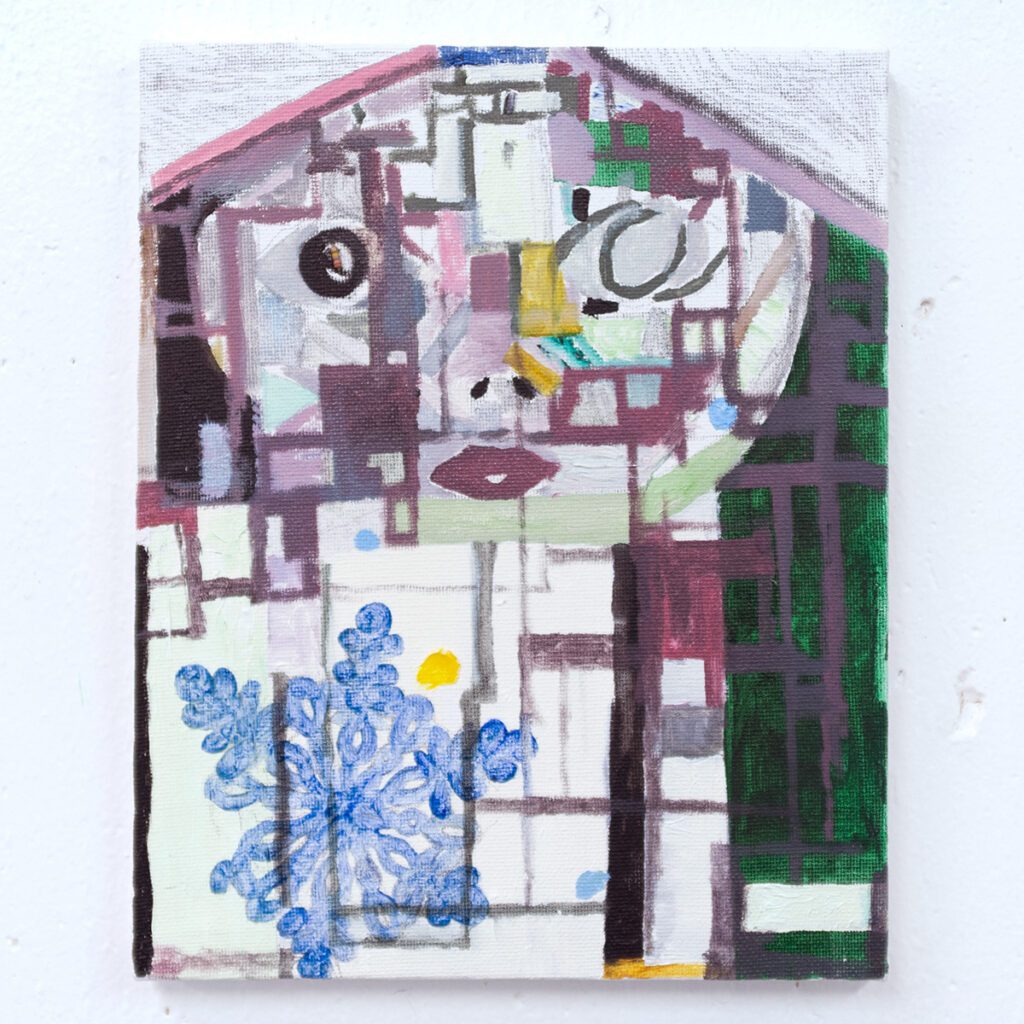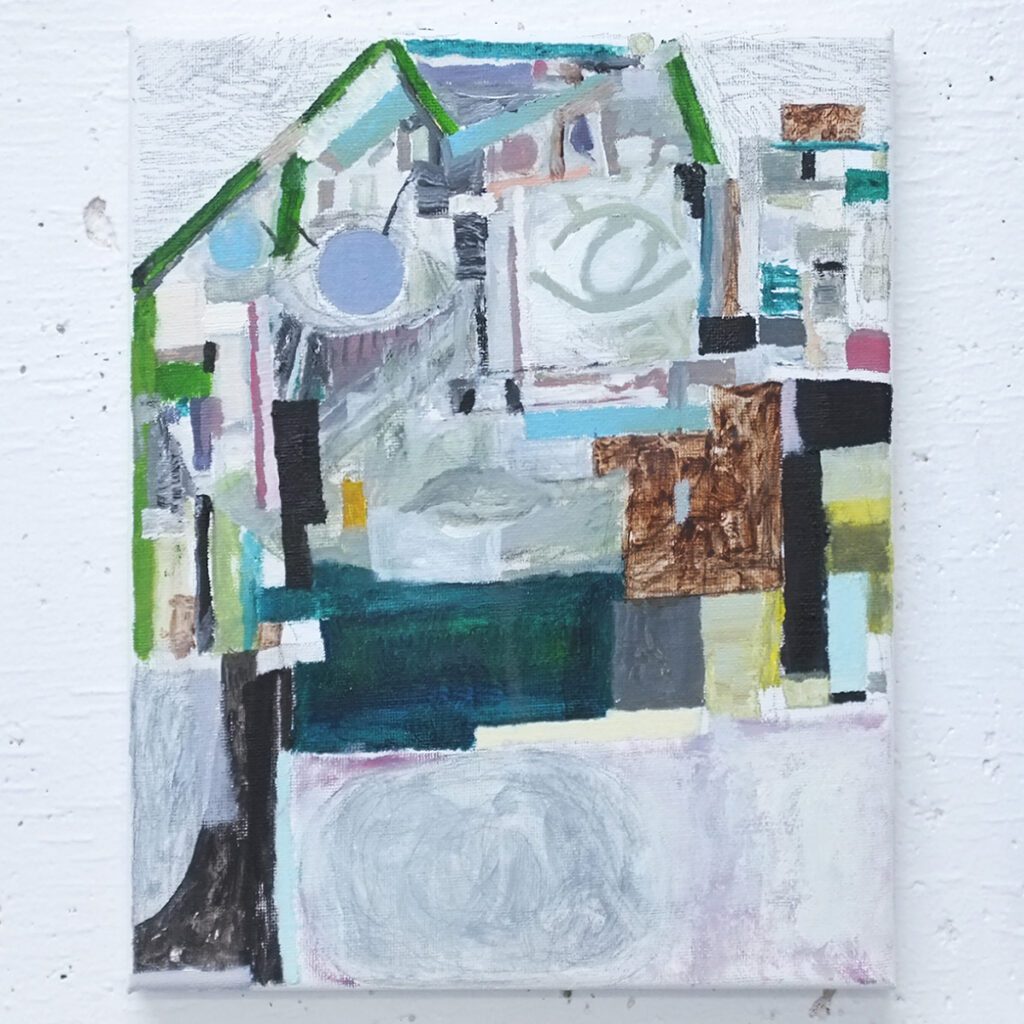Jasper van Alderwegen at the Vault Gallery
18 May 2024By Dani Neira

Transpiring in the Vault Gallery, Jasper van Alderwegen’s solo exhibition Aediculae II is the second iteration of an exhibition that almost happened… Due to being locked out of their studio by a Montréal slumlord, the artist didn’t have access to the works intended for Aediculae I. In the eleventh hour, an alternative exhibition (aptly retitled You’re Exactly What I’m Not) was devised from pieces that weren’t being held hostage. How fitting then, that this second iteration takes place in a converted vault, a room normally intended for safe-keeping valuables!
Following the sound of melancholic music emanating from inside the gallery, I walk through a thick metal door into an austere room. The sound seems to be coming from a white cylindrical structure in the centre of the room; it is about four feet tall, tree-like, and adorned with a small, artificial blue-bird perched on one of its tubular offshoots. Jutting out of its base are iPods, iPhones, and an iPad, but it isn’t clear whether the music is coming from one of these devices. Seven small paintings line the walls; in them, rudimentary shapes form faces and buildings are almost obscured by restless swatches of colour.

What is immediately clear to me is that van Alderwegen is a collector. Not a High Art collector or eBay flipper, but rather a person who gathers things with little to no monetary value—discarded shopping lists, beach glass, childhood toys—objects that are then held and displayed tenderly in shelves, boxes, or albums. Perhaps these vessels of display could be described as aediculae: small structures used as shrines.1 In Ursula K. Le Guin’s book The Carrier Bag Theory of Fiction (1986), she proposes that containers were the earliest human tool, countering the well-worn story of the spear.2 Receptacles were needed to hold items like nuts and seeds, or maybe beautiful things that we wanted to bring home and share with others. In Aediculae II, the artist’s lexicon of odds and ends poses the question, why do we collect the things we do, and how do we build meaning and personal value around them?
All but one of the artist’s paintings are titled Aedicule (Diary Entry) (2023), along with an identifying number. The outlier, “Aedicule (Snowflake) (2023),” differs in its befitting addition of a large blue snowflake to the composition. The scale of the paintings, an intimate 8″ x 10″, coaxes me to lean in conspiratorially. Akin to vaults, diaries can be containers for secrets held under lock and key. In fact, the reverent repetition of form throughout the paintings reminds me of writing my crush’s name over and over again in my fifth-grade diary. I momentarily relive my bedtime ritual in 2009, where I would retrieve my diary from under my mattress and confess to its pages. Of course, van Alderwegen’s medium of choice is not a purple gel pen on lined paper, but a muted, many-hued oil palette that leans into greens, blues, and greys.

Maybe I was thinking of the fifth grade because the paintings remind me of children’s drawings of houses. With upside down “V”s signifying rooftops, van Alderwegen’s buildings are personified with flat outlines of eyes, noses, and mouths incorporated into a patchwork of circles, squares, and rectangles. Each canvas repeats these basic elements, although no two paintings are the same. The rooftops create a geometrical container, with uneven pencil strokes sketching out a grey sky, but there is no clear end to these buildings which are suddenly cropped by the edge of the canvas. Reminiscent of glancing out of a tall building’s window, the field of vision is encompassed by the tops and middle floors of buildings, with fragments of sky peeking between their urban bodies.
With the grid-like shapes and loose brushstrokes hinting at a city in motion, I feel an affinity with these innocent forms, and question what they might be feeling underneath their vacant expressions. Do they thrive amid chaos? Or are they like me, easily overstimulated? As I inspect each painting, I notice that four of them have ceramic resistors and capacitors incorporated into the patterning. Most visible from a side view, the electronic components poke out of the canvas searchingly. Woven into the building’s patchwork, they take on a new function as they attempt to camouflage themselves into this new entity. It is like they are in the process of growing into themselves, and I have caught them at that endearing, awkward point of becoming.

As I move to and from different works, the artist’s looping musical composition seeps into my memories and personal associations. The synthetic symphony, emerging from the installation Tree (Passive Amplifier) (2023), juxtaposes the rich chords of string instruments with expanses of silence and an infrequent electronic beeping. Building an atmosphere that is medieval, religious, cinematic, and digital all at once, it is difficult to place the music in a certain time.
In the stark, windowless gallery space, this temporal disorientation adds to the peculiar sense one gets from being in a liminal space, or heterotopia. As described by Foucault, heterotopias are real spaces that are “other,” both intimately connected to and separated from the everyday.3 These spaces have the capability to reflect and disrupt the outside by calling attention to certain cultural values. I consider this as I investigate Tree (Passive Amplifier) and realize that its cylinder is made of cardboard painted white, with what looks like paper towel rolls extending as branches. I am charmed by this, and by the synthetic blue feather glued askew on the bird’s head. The use of obvious construction and inexpensive craft materials creates an intriguing tension with the electronic devices on the ground: pink, blue, and white Apple products that extend from the cylinder like roots, giving it the appearance of a smokestack or a tree cyborg. I wonder if these gadgets are broken, as most of them have smashed, cracked, and scratched screens. They can’t be worth much anymore, I think to myself.
In the material excesses of capitalism, we are surrounded by objects. We discard the broken, single-use, and out of fashion, and replace them with the ease of one-day shipping. Aediculae II is the antithesis of throwaway culture, acting instead as a protective vessel. While capital value dictates what is worth safe-keeping in vaults and privately owned properties, the works in this show sanctify the everyday and imbue it with personal value. Like a large blue snowflake, the exhibition’s heart is unique, intricate, and sentimental. van Alderwegen has a knack for collecting and harmonizing disparate materials to create an affective atmosphere that is both familiar and transforming. As a shrine to the instability of value, memory, feeling, and meaning-making, Aediculae II left me wondering where my childhood diaries are. I decide my mother must be keeping them safe.
- “Aedicula.” Merriam-Webster.com Dictionary, Merriam-Webster, https://www.merriam-webster.com/dictionary/aedicula.
- Ursula K. Le Guin, The Carrier Bag Theory of Fiction (London: IGNOTA Books, 2020), 29.
- Michel Foucault, “Of Other Spaces,” Translated by Jay Miskowiec, Diacritics, vol. 16, no. 1, 1986, 22–27. JSTOR, https://doi.org/10.2307/464648, 3.
Aediculae II ran from November 16 – December 9, 2023 at the Vault Gallery in Victoria, BC.
Feature Image: Installation view of Aediculae II by Jasper van Alderwegen. Photo courtesy of the artist.



